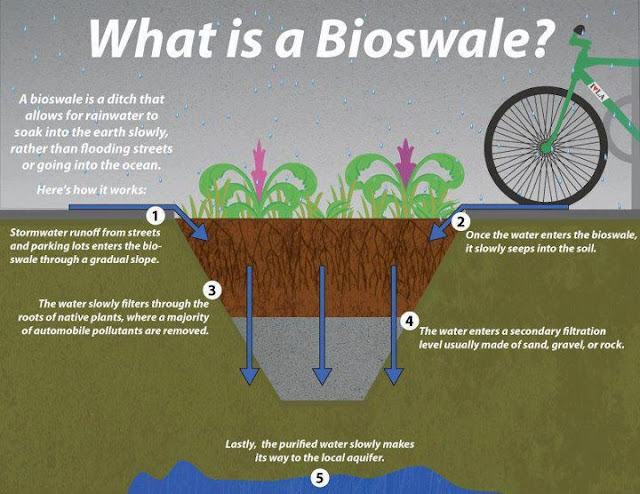Bioswales are landscape elements designed to remove silt and pollution from surface runoff water. They consist of a swaled drainage course with gently sloped sides (less than six percent) and filled with vegetation, compost and/or riprap.[1]:19 The water's flow path, along with the wide and shallow ditch, is designed to maximize the time water spends in the swale, which aids the trapping of pollutants and silt. Depending upon the geometry of land available, a bioswale may have a meandering or almost straight channel alignment. Biological factors also contribute to the breakdown of certain pollutants.
A common application is around parking lots, where substantial automotive pollution is collected by the paving and then flushed by rain. The bioswale, or other type of biofilter, wraps around the parking lot and treats the runoff before releasing it to the watershed or storm sewer.
Contaminants addressed
There are several classes of water pollutants that may be arrested with bioswales. These fall into the categories of silt, inorganic contaminants, organic chemicals and pathogens. In the case of silt, these effects are resultant turbidity to receiving waters. Inorganic compounds may be metallic compounds such as lead, chromium, cadmium and other heavy metals. Lead is the most prevalent chemical of this class, deriving from automotive residue (e.g. surface spillage of leaded gasoline). Other common inorganic compounds are macronutrients such as phosphates and nitrates. Principal sources of these nutrients are excess fertilization, which can cause eutrophication in receiving waters. Chief organic chemicals are pesticides, frequently over-dosed in agricultural and urban landscaping. These chemicals can lead to a variety of organism poisoning and aquatic ecosystem disturbance. Pathogens typically derive from surface runoff containing animal wastes and can lead to a variety of diseases in humans and aquatic organisms.
Examples
Two early examples of scientifically designed bioswales for large scale applications are found in the western United States. In 1996 for Willamette River Park in Portland, Oregon a total of 2330 lineal feet of bioswale was designed and installed to capture and prevent pollutant runoff from entering the Willamette River. Intermittent check dams were installed to further abet silt capture, with the outcome of reducing 50 percent of all suspended solids entering the river system.[3]
A second example of a large scale designed bioswale is at the Carneros Business Park, Sonoma County, California. Starting in 1997 the project design team worked with the California Department of Fish and Game and County of Sonoma to produce a detailed design to channel surface runoff at the perimeter of a large parking area. Surface runoff consists of building roof runoff, parking lot runoff and overland flow from properties to the north of the project site. A total of two lineal miles of bioswale was designed into the project. The purpose of the bioswale was to minimize runoff contaminants from entering Sonoma Creek. The designed bioswale channel is grass-lined, but almost linear in form. Downslope gradient is approximately four percent and cross-slope gradient is approximately six percent.[4]
Also Visit For~~~~~~~~~~~~~~~~~~~~~
- Useful Information (Info Link Zone )
- In NEWS Person
- Indian Exams Zone (Alerts, Guidance n Tips)
- Indian Railways News n Alerts
- Sarkari Naukari (Govt. Jobs) NEWS Updates
- General Knowledge (For Exams)
- Latest Current Affairs (Monthly N Weekly)
- Books Review Zone (also for Competitive Exams Book)
- Positive Inspirational Quotes
- Competitive Exams Coaching Reviews








![Essay topic in last 19 years (1993-2011)[Analysis]](https://blogger.googleusercontent.com/img/b/R29vZ2xl/AVvXsEhQQhNVI_VJg7hIANowLl2XgbyxIzo0SiqEC5nQWkstYnI70rc1Wp-eUpFGbDNcGtOrp5Xzfl7kP87GswXrMwmH5rl4pzm3-pf93RSOPvHmdJjstv5maeN2HSt_QUbQclRP8Ze6p9mM4jP_/w680/The+occurance+table+for+UPSC+Essay+topics+in+mains+exam.png)


::::Your Comments are Valuable for Us-Post your queries below::::.